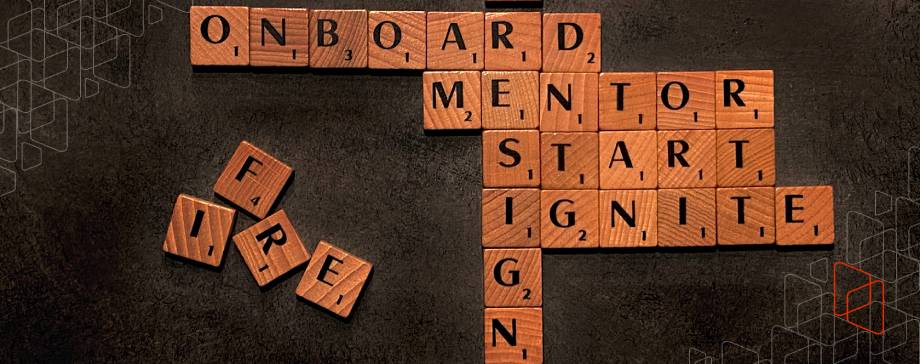Brett Knowles, pm2 Consulting
Brett is a long-time thought leader in the Strategy Execution space for high-tech organizations, beginning in the late 80’s while teaching at Harvard and being involved in the initial Balanced Scorecard research and books. His client work has been published in Harvard Business Review, Forbes, Fortune and countless other business publications.
Pub: April 2 2021
Upd: May 30 2023
Part 3 of our 3-part Work from Home Fatigue series.
In this article, we are primarily focused on the aspects of our new ways of working (web-meetings, WFH, etc.) related to the organization and personal performance. In this third part of our Work From Home Fatigue series, we provide simple solutions and explanations to the exposed problems and symptoms in our previous articles.
The problems we exposed around Work from Home Fatigue can be found in Part 1, and the symptoms of those problems can be found in Part 2.
Seven ways OKRs solve Work From Home Fatigue
In no particular order:
Strengthen psychological safety on your team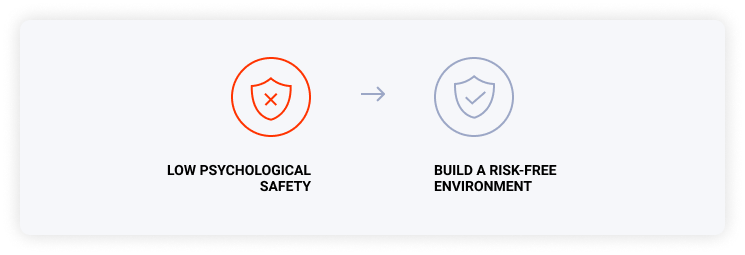
To-do:
-
Ensure that you listen carefully in 1-on-1s or team meetings, and respond in a way that moves the team towards solutions without heavy judgments and blame.
-
When disagreements or conflicts come up, big or small, name them! That’s the most immediate way to depressurize a situation, acknowledge what’s already happening, and move forward toward resolution.
-
Make sure your OKRs are backed up by a clear accountability framework (e.g. RACI or RAPID, etc.). Always run OKR meetings with a Facilitator who monitors the meeting for tone, and has the authority to address issues that come up.
-
If your team environment feels regularly uncomfortable, get support! Some simple interventions and agreements may lighten up the atmosphere.
Basic psychological safety is essential for OKR practice:
Candid performance conversations are the heart and soul of OKR practice. Team members need to know they can risk talking transparently together about what’s working and what’s not.
Psychological safety doesn’t mean feeling comfortable all the time!--it means feeling confident enough to open up and work through uncomfortable topics.
Likewise, revisiting and revising Objectives relies on a free, trusting communication environment. No person or team communicates perfectly--so think about psychological safety as an ongoing process of confirming, safeguarding, and fine-tuning the environment we need on the team to do our best work together.
Why this matters:
When close collaboration is required for the team to function, these “safety” issues become absolutely critical for the business.
The Pandemic impacts on our teams, families, and communities stress communication on all these levels. So the normal risk of lower communication quality in asynchronous communication (email, Slack, Team messages, etc.) is intensified under Covid-era stressors, resulting in an increase in “safety issues.”
To a lesser extent, we see an increase in “safety issues'' in web meetings, largely caused by the lack of personal control and subtle interpersonal signals that guide us in face-to-face interactions. When a team starts to experience more miscommunication, irritability, or hesitancy to speak one’s mind, it’s an opportunity to grab hold of the psychological safety issue and improve the environment.
- Create a regular cadence of communication
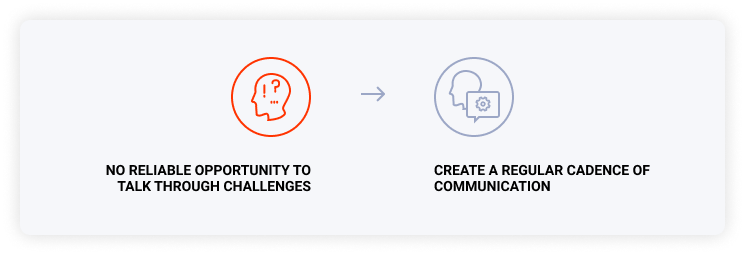
To-do:
Create a regular rhythm for talking and working through challenges.
How OKRs enable a regular cadence of communication:
Building a solid team rhythm of OKR meetings reinforces clarity, accountability, and support all at the same time. Everybody knows they’re accountable and that they will get support for working through obstacles. The opposite is also true: when the team’s rhythm is broken, the accountability, transparency, and performance impact of OKRs will degrade.
Why this matters:
The fix here is very straightforward, and for that reason, it’s very difficult! Creating a dependable rhythm of team meetings, in which there is enough “space“ to really address challenges together, with everyone’s attention and participation, is a true challenge under stress.
OKRs give us a tool to filter out the static and ensure we address the things that matter, but then there is the challenge of making those meetings and conversations productive. How do you do that? Try using these guidelines:
-
Establish a regular schedule of meetings so your team has a reliable “heartbeat“.
-
Appoint a facilitator who can track and get feedback on everyone’s involvement and manage the pace of the meeting.
-
Prioritize agenda items and identify intended objectives before beginning each item.
-
The facilitator is responsible for helping the team identify whether the objective has been reached, whether everybody’s giving input, whether more time is needed, etc.
-
If your team rhythm gets thrown off, acknowledge that, and discuss how to get back on track.
Normalize a team system of recognizing when there’s not enough time to handle everything— set expectations for the tone and process of meeting so that it’s not overly rushed and so that everybody is involved.
- Create realistic boundaries that enable you to better manage your attention & energy
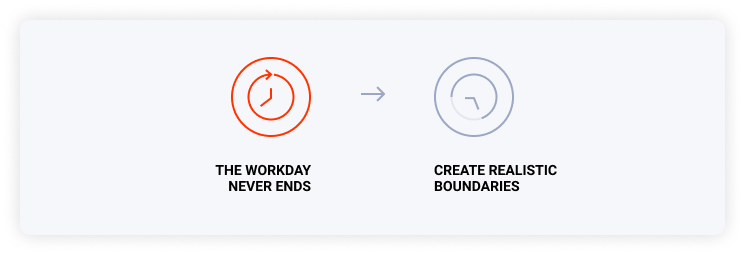
To-do:
-
Moving in the direction of a healthy work/life balance is a daily challenge while WFH.
-
Start by breaking up the cycle of back-to-back meetings--take breaks to replenish your ability to pay attention.
-
The good news: building better individual & teamwork habits during lockdown strengthens your team’s long-term sustainability. And this will continue to pay dividends in the post-pandemic world.
-
Identifying and breaking teamwork habits that drain you, including repeatedly over-promising, is an investment in your own attention, energy, and effectiveness.
How OKRs enable creating realistic boundaries:
Taking care of ourselves physically--by taking regular breaks, moving around, drinking water, eating, getting some fresh air--is taking stewardship of your own attention and creative energy, and enables you to make better decisions. If you get locked into endless work, something as simple as the Pomodoro Technique can help break up your day and prevent feeling tired of working.
Clearing your head enables you to set better Objectives and Key Results, to more realistically plan and organize your activities. Ensure you have what we call “a fair deal”: do not take on new Objectives without checking your capacity to complete them…and if you don’t have the capacity, ask your Leader which Objective you should drop in order to achieve this new one. If necessary, set an objective about your working hours and make sure it stays green (not too high nor too low).
Why this matters:
- Setting healthy boundaries around the workday is even more important when people are doing solitary work at home. Addressing how to better manage energy and attention with the team is an opportunity to engage and support team members in refining group and individual work. Encourage your organization to experiment with new strategies, then set policies and best practices to optimize the WFH workday.
- Try out concrete strategies, then debriefing how they work, is especially useful: give people observable criteria they can use to judge when they need a break or have hit a point of diminishing returns. Take care of your fellow-workers. Take note when they are exceeding those policies.
- Research indicates that it is invaluable to break-up your workday physiologically and attention-wise in order to maximize well-being: like taking a walk, using techniques like Pomodoro, making sure to get up and exercise at least several times a week if not daily.
- Nurture people’s non-work contact
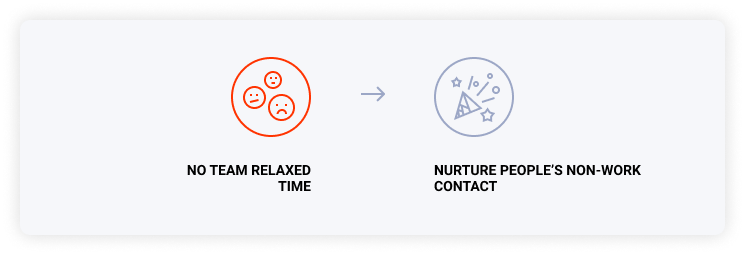
To-do:
-
Value the time people take to bond with each other. As a leader, you can’t force this to happen, but you can encourage teammates to connect by making the space for it, and by showing people that every instant on Zoom doesn’t need to be laser-focused on work.
-
Consciously allowing time for people to “arrive” in an online meeting allows for the kind of human-to-human contact that used to happen in the hallway outside the conference room.
-
If you look for opportunities, you’ll find out what works on your team. Some teams use icebreakers at the start of meetings; some make an effort to celebrate special events; other teams create virtual watercooler events to connect with each other. Employee engagement can be nurtured even through a screen! In one company, a couple of the millennials discovered during an accounting call that the corporate Controller also plays League of Legends. That night, the three of them formed a League of Legends team... and came in third!
How OKRs support non-work conversations:
Make sure your OKRs cover culture, employee engagement and employee satisfaction. Next, make sure your OKR system enables and encourages team and one-on-one meaningful contact – conversations that go beyond “doing work.” Find the ways of connecting that fit your team and don’t insist on participating, invite! The whole point is to allow for a positive experience that breaks through the Covid bubble.
Why this matters:
Breaking through the bubble of pandemic isolation can be tough. Physical distancing has a huge impact on our daily lives, no doubt. But the little steps you take to humanize your team’s contact with each other can have a big impact on the team environment. There’s solid psychological research to support the idea that relating to others is more conducive to a sense of personal well-being and flourishing than isolated acts of self-care. Bottom line, lightening the environment and humanizing peoples’ contact can go a long way to building cohesion on your team!
- Depend on your Team - and let Them Depend on You
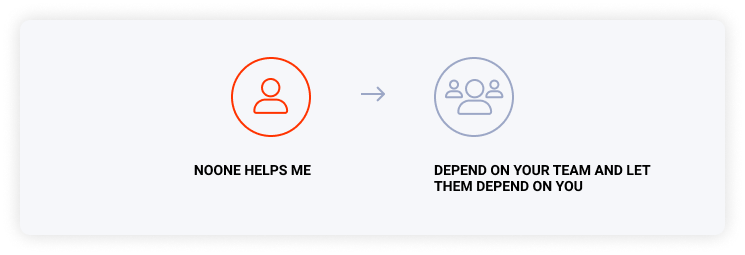
To-do:
- Be dependable - help out every time you see help is needed.
- Negotiate what support team members can rely on from each other.
- Structure your OKRs around team achievements, not individual ones.
OKR practice strengthens healthy interdependence
Make sure your OKRs score the team, not the individual. Ensure the team’s progress is visible to all. What we’re talking about here is building healthy interdependence on your team: that means strong commitment to shared objectives, and support for each other to maximize the team’s success. In big or small ways, there’s always room for mutual help in your organization
Why this matters:
Often what’s missing in most instances is a social compact within a team in which they can make and revise agreements when needed about how to call upon each other for help.
The fair deal here includes setting expectations about what kind of help, how quickly to expect help, stuff like that. Setting aside time for the team to talk about what kinds of help they need from each other, clarifying what kinds of support they can expect from each other, is exactly the kind of contracting that builds healthy interdependence. It’s very helpful to designate a facilitator for this exercise, so everyone can participate fully.
This kind of contracting exercise is an excellent opportunity to acknowledge the importance of each person’s contribution, motivate people by affirming support for their efforts, and encourage the free flow of timely information among teammates.
- Practice Active Listening
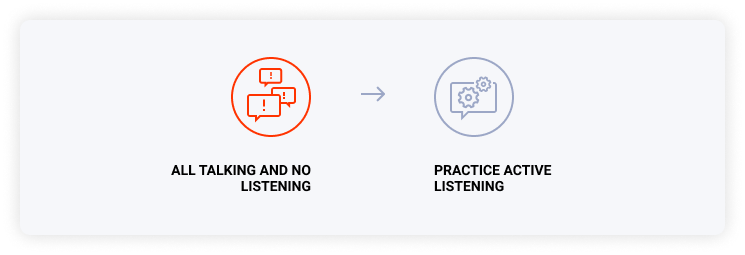
To Do:
-
Pause (i.e. stop talking yourself!).
-
Give your full attention to what the other person is saying.
-
Briefly restate their core message, to confirm understanding.
-
In your team meetings, seek to listen twice as much as you talk.
Why do this?
-
Using active listening ensures you understand the other person’s key points.
- The purpose is to maximize high-quality, effective communication.
Active listening empowers your OKR practice by:
-
Ensuring everybody’s on the same page: for example, about what the Objective means, what’s its status, and what if any impediments have come up.
-
Safeguarding the team’s attention by maintaining focus.
-
Curbing anyone’s tendency to take up too much airtime, by pausing for clarification when needed.
- Reinforcing the message that every team member's ideas matter.
Why this matters:
Listening is one of the most important skills you can have. How well you listen has a major impact on your job effectiveness and on the quality of your relationships with others. The way to improve your listening skills is to practice "active listening”, when you make a conscious effort to hear not only the words that another person is saying but, more importantly, the complete message being communicated.
You must pay attention to the other person very carefully. You cannot allow yourself to become distracted by whatever else may be going on around you, or by forming counter arguments in your head while the other person is still speaking. Nor can you allow yourself to get bored, and loose focus on what the other person is saying.
There are five key active listening techniques you can use to help you become a more effective listener:
1. Pay Attention: Give the speaker your undivided attention, and acknowledge the message. Recognize that non-verbal communication also "speaks" loudly.
2. Show That You're Listening: Use your own body language and gestures to show that you are engaged.
3. Provide Feedback: Our personal filters, assumptions, judgments, and beliefs can distort what we hear. As a listener, your role is to understand what is being said. This may require you to reflect on what is being said and to ask questions.
4. Defer Judgment: Interrupting is a waste of time. It frustrates the speaker and limits the full understanding of the message.
5. Respond Appropriately: Active listening is designed to encourage respect and understanding. You are gaining information and perspective. You add nothing by attacking the speaker or otherwise putting them down.
- Set clear priorities and accountabilities
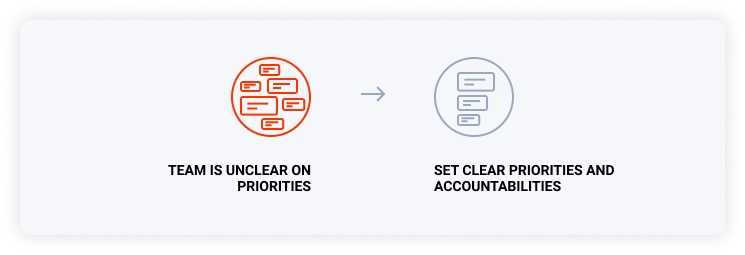
To-do:
-
Make work priorities explicit, and revisit them regularly to confirm they’re still valid.
-
When the team’s work priorities need to change, discuss and confirm the change directly with the team: spell out what’s changed!
-
Memorialize the change in priorities. Everyone on the team should be able to point to a single document, or slide, or list of the revised set of priorities.
-
When making a change, pause to take stock of any second-order implications of the change--what other activities will be affected?
- Do all of this in a ceremony-- in a team meeting, not in secret.
Prioritization is the core of OKR practice
This is one of OKRs greatest contributions – OKRs are specifically designed around our key priorities. They make our priorities explicit and allow everyone to see on a weekly basis what our priorities are, and how we are performing against them.
Details:
Priorities come from the top of the business down, based on our strategies
-
The first thing we need to do is clearly prioritize a shortlist of top-level Objectives. Prioritization and reprioritization enables the Executive team and then the business as a whole to focus its energy on achieving the highest value outcomes.
-
Next, we need to accurately cascade them down through departments to teams and even individuals, without suffering from ‘the broken telephone’. When the top-level priorities change, we need to be able to cascade them down through the organization within hours (not days, weeks, months or quarters).
-
Each team (or person) should be able to answer the question, “What do I do to contribute to corporate success?” We each need to know what our role in achieving that (cascaded) Objective is?
In closing
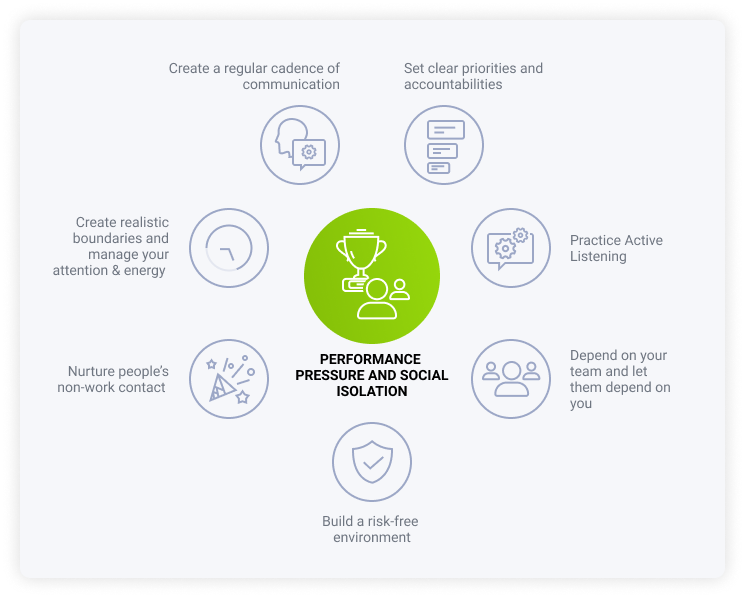
Tons has been written about "Zoom Fatigue" and the stresses of WFH (Working From Home). There are real issues here that are well understood - but luckily, there are also real solutions that are proven to work.
Our intention is to let people know that what they are feeling is "normal"; it is nothing new - these issues are well known in the psychology community... And there are proven solutions. This is not black-magic stuff of business-writers, but simple pragmatic things we can do to take care of each other and ourselves.
- Relevant
- Recent
- Topics
- Archive
- April 2023 (1)
- March 2023 (1)
- June 2022 (1)
- May 2022 (3)
- April 2022 (3)
- March 2022 (5)
- February 2022 (2)
- January 2022 (3)
- December 2021 (3)
- November 2021 (4)
- October 2021 (5)
- September 2021 (8)
- August 2021 (7)
- July 2021 (2)
- June 2021 (3)
- May 2021 (5)
- April 2021 (8)
- March 2021 (4)
- February 2021 (3)
- January 2021 (3)
- December 2020 (6)
- November 2020 (9)
- October 2020 (1)
- September 2020 (5)
- August 2020 (4)
- July 2020 (1)
Discover More Hirebook Posts

